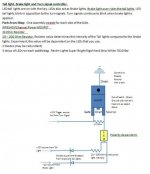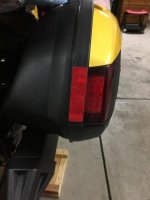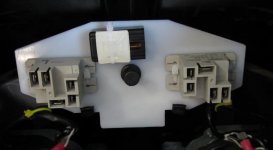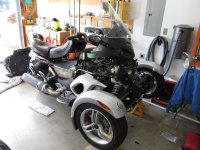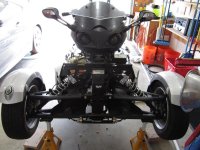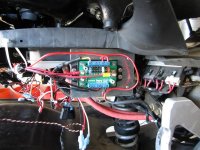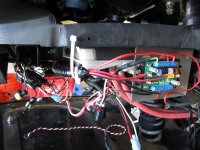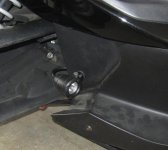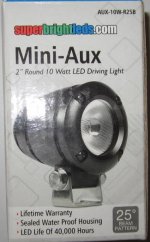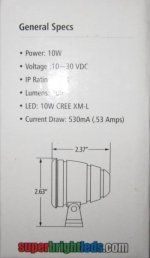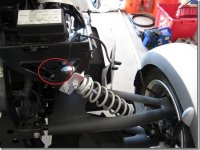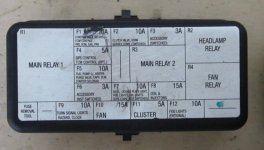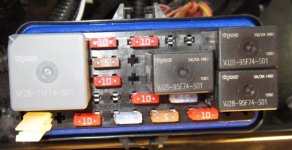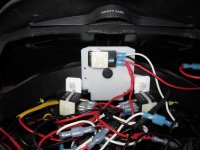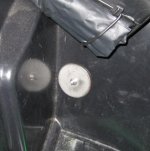Hi folks,
Here is the splice into this accessory lead at the F3 position:
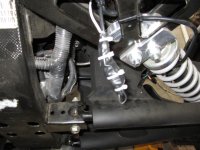
I just stripped back the insulation on the hot side of these two wires, wrapped everything in electrical tape, tied it up with zip ties & put it back into position. This accessory lead had a rubber boot on it for when you would connect it to lites, etc in the frunk. I just cut the boot off & had access to the wires:
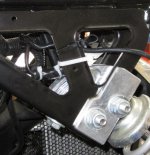
The next step was to locate/mount the three relays. I wanted all of them back, under the instrument panel. This is where things went poorly. After trying three locations back, under the instrument panel, the fourth time worked. However, I am quite certain that one of the first three attempts is what cost me the damaged ( I think ) Normally Closed relay.
Here is the Normally Open relay, mounted on a piece of plastic which is held in place by one of the push pins that holds a lot of the tupperware in place on Spyders:
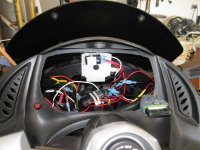
I just drilled a 5/16" hole in the plastic piece and in the flat plastic area that is back there.
I tried to mount the two Normally Closed relays on a couple of pieces of plastic in a similar manner but they would always get in the way of the instrument panel, which is quite thick. I am now convinced that one time while trying to put the instrument panel back into place, I damaged one of the Normally Closed relays; at least, I think this is what happened.
I then wired everything together & started her up. This is where things got really goofy. When I first fired her up the right side Driving Lite was on - I have no idea why. I spent about 2 - 2 1/2 hours trying everything that I could think of to get the Driving Lites to work with the turn signals. I could only get the left side Driving Lite to work with the left turn signal. The right side Driving Lite would do all sorts of crazy things. I decided that this was now above my knowledge, so I removed both Normally Closed relays & just wired things up so the Driving Lites work properly. By using the F3 position in the fuse panel, the Driving Lites come on when the key is turned. They go off when the key is turned off; but they wait about 10 seconds after the key is turned off, then they turn off. This was a little unnerving at first but it is easy to get used to.
Here are the Driving Lites in operation:
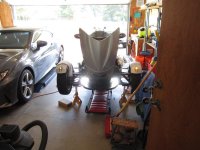
While I had the Spyder tore down I decided to do some other stuff to it. My coolant bottle was low so I added more coolant. One side of my brake fluid reservoir was low ( the one that always seem to be the one that goes low ), so I added more brake fluid. I also changed out the vacumn hoses with the silicon ones. Gene De Lany ( Chupaca on here ) was very helpful with this effort.
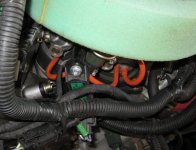
In conclusion, my Driving Lites work like I wanted them to ( I just need to get them aimed properly ). I could not get the Driving Lites to function with the turn signals; this is not that important to me. After spending a fair amount of time giving it a lot of thought, I am thinking that the right side Normally Closed relay became damaged while trying to find a good location for it. I might just try to find a couple of smaller-in-size Normally Closed relays and try it again; all of the wiring is still there.
I also want to thank David Craft ( Haze on here ). Here sent me his schematic on how he built his own Normally Closed relays. I found it very interesting but I am simply not that good with this whole 'electricity' thing. I rather like to just buy what will do the job and go forward.
If anyone has any questions, just jump in and ask; I'll do my best to answer,
Jerry Baumchen

